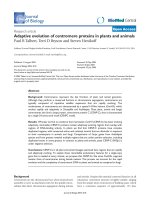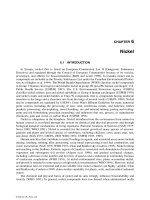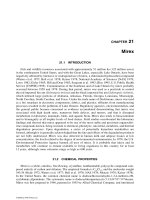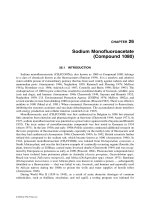3 4 ways plants and animals interact (life science)
Bạn đang xem bản rút gọn của tài liệu. Xem và tải ngay bản đầy đủ của tài liệu tại đây (3.26 MB, 14 trang )
Genre
Nonfiction
Comprehension Skill
Draw Conclusions
Text Features
• Labels
• Diagrams
• Glossary
Science Content
Plants and
Animals
Scott Foresman Science 3.4
ISBN 0-328-13818-5
ì<(sk$m)=bdibia< +^-Ä-U-Ä-U
Vocabulary
carnivore
competition
consumer
decay
decomposer
disease
germs
herbivore
omnivore
predator
prey
producer
What did you learn?
1. How do animals get energy
to hunt for food?
2. What scientific term describes what
happens when grass grows, gets
eaten by a mouse,
and Wilson
then that
by Donna
mouse gets eaten by an owl?
3. What kind of animal has caused harm
to many trees in the United States by
eating too many of their leaves?
4.
In this book,
you have read about producers and
consumers. Describe how producers
and consumers interact. Use examples
from the book.
5.
Draw Conclusions Suppose you
have seen a lot of mice in your
backyard. You have also seen hawks
hunting them. Suppose that one day
you saw far fewer mice and no hawks.
What might you conclude?
Picture Credits
Every effort has been made to secure permission and provide appropriate credit for photographic material.
The publisher deeply regrets any omission and pledges to correct errors called to its attention in subsequent editions.
Photo locators denoted as follows: Top (T), Center (C), Bottom (B), Left (L), Right (R), Background (Bkgd).
5 (BR) ©Jerry Young/DK Images; 9 (B) Gerry Ellis/Digital Vision; 12 Getty Images; 15 (CL) ”Barrie Watts/DK Images;
17 (CB) ”Barrie Watts/DK Images; 20 (Bkgd) Getty Images.
Scott Foresman/Dorling Kindersley would also like to thank: 13 Stephen Oliver/DK Images.
Unless otherwise acknowledged, all photographs are the copyright © of Dorling Kindersley, a division of Pearson.
ISBN: 0-328-13818-5
Copyright © Pearson Education, Inc. All Rights Reserved. Printed in the United States of America.
This publication is protected by Copyright, and permission should be obtained from the publisher prior to any
prohibited reproduction, storage in a retrieval system, or transmission in any form by any means, electronic,
mechanical, photocopying, recording, or likewise. For information regarding permission(s), write to
Permissions Department, Scott Foresman, 1900 East Lake Avenue, Glenview, Illinois 60025.
3 4 5 6 7 8 9 10 V010 13 12 11 10 09 08 07 06 05
Earth is a very special place. One of
the things that makes it special is the way
plants and animals live together, or interact.
Sometimes they live together in a way that
helps one another. Other times, they live
together in a way that hurts one another.
Plants and animals can also live
together in ways that neither
help nor hurt one another.
Living things interact in many
different ways. However, all
living things need other living
things in order to live.
2
3
How Living Things
Interact
Some animals live together in groups and help
each other out. When an ant finds some food, it
tells other ants where the food is. Together, the
ants carry the food back to their home.
Canada geese with goslings often gather with
other mother geese and their goslings. One or
two of the mothers will watch over the goslings,
while the rest of the mother geese go hunting
for food.
Animals who live in herds may form a tight
circle for protection against bad weather or
an enemy. Horses caught in a snowstorm will
put their heads together in a circle for warmth.
Often, older horses will push the younger horses
into the center of the circle for added protection.
4
Sometimes when two animals interact, only
one animal will be helped. This happens when a
barnacle attaches to a whale. The adult barnacle
does not swim on its own. Instead it eats the bits
of food that flow past as the whale swims. The
whale is neither hurt nor helped by having the
barnacle on its body.
Barnacles
Sometimes plants and
animals work together to
help each other. Fruit
bats help pollinate
certain fruit trees in
tropical rain forests. The
trees get pollinated and
the bats get a meal.
5
Living Things
Get Energy
For plants to be able to grow, bloom, or
make seeds, they must have energy. In order for
animals to be able to build homes and search for
food, they must have energy.
Green plants are the only living things that
can make their own food. They do this by
taking energy from the Sun.
Green plants are able to make
their own food. This makes them
producers. All other living things
get energy from the foods
they eat. This makes them
consumers. Consumers get
their energy by eating green
plants, or by eating animals
that have eaten plants.
6
7
Carnivores,
Herbivores,
And Omnivores
It can take a long time for the energy in a
plant to get to an animal. This is because not all
animals eat plants. Animals that eat only meat are
called carnivores. You already know about many
kinds of carnivores. Tigers, eagles, and mountain
lions are carnivores.
8
Animals that eat only plants are called
herbivores. Goats, horses, and rabbits are
herbivores. Some animals eat both plants and
other animals. These animals are known as
omnivores. Chimpanzees are
omnivores. They eat insects,
fruits, seeds, and many
other things.
9
Follow the Energy
You might have questions about how
carnivores get their energy from green plants. The
answers are found by looking at a food chain.
Energy moves from producers to consumers in a
food chain.
Think of a clover plant growing in a field.
The clover plant is green. It makes its own food
energy from sunlight. The clover is a producer.
Rabbits are herbivores. They eat the clover.
By eating the clover rabbits take in energy from
the plant. Rabbits are consumers.
Marsh hawks are carnivores. They eat rabbits.
If a marsh hawk catches and eats a rabbit, it
will get energy from the rabbit. Now think
back to where the rabbit got its energy. Do you
remember? It was in the clover that the rabbit ate.
The marsh hawk gets energy from both the rabbit
and the clover.
Rabbit
Clover
10
Hawk
11
Food Chains
All living things belong to a food chain. Food
chains start with a producer, such as clover. At
the end of each food chain is a consumer, such as
the marsh hawk.
Most food chains have predators and prey.
A predator is an animal that hunts for its food.
Prey is the animal that is hunted. The marsh
hawk is a predator, and the rabbit is its prey.
12
There can be more than one food chain
in one place. In a field where clover grows,
grass might also grow. Mice eat the grass.
Owls eat the mice. In this food chain, grass
is the producer. The mice and the owls are
consumers. Owls are predators. They hunt
the mice, which are the prey.
Another food chain could start when a
plant’s leaves are eaten by a deer. That deer
could become prey for a bobcat.
13
Food Webs
One food chain cannot
show all the plants and
animals that pass on energy,
even in a small place. Plants
and animals might be eaten
by more than one thing.
Food webs show what
happens when food
chains cross.
Look at the food web
on the right. You read that
marsh hawks eat rabbits.
They can also eat mice. Owls
can eat rabbits. Bobcats can
eat deer, rabbits, mice, and
even hawks! Food webs
show interactions between
many living things in an
environment.
14
15
How Food Webs
End and Change
It may seem like the food web that we just
described ends with the bobcat. However, people
sometimes hunt top predators such as bobcats.
Other times, accidents, disease, or natural
disasters may also kill animals such as bobcats.
If that happens, scavengers such as bugs, crows,
and coyotes will eat the bobcat. A scavenger is an
animal that eats garbage or dead animals.
What would happen if one part of a food
chain disappeared? For example, suppose a lot
of mice were killed or died. The barn owls and
marsh hawks might not have enough food. That
might cause the hawks and owls to go hungry.
If they became hungry enough, they might be
forced to move to a different place.
Vultures feeding on
a dead sheep
16
17
How Living Things
Compete
If the barn owls and the marsh hawks
both wanted to find mice, they would be in
competition for the mice. In this case, two
different kinds of predators are in competition
for food. Usually, the stronger and faster
predator will succeed.
Sometimes the competition between living
things is not for food but for space. New homes
may be built where animals used to live. Because
of this, people may find deer in their backyards
eating garden plants and bushes.
Many years ago, a plant called kudzu was
brought to the United States. After a few
years the kudzu started growing all over trees
and bushes. It began to cover and choke out
other plants. The kudzu was too successful at
competing with other plants for space to grow.
Raccoons eat
garbage in the city.
18
19
Environments
Change
Environments can be changed by more than
just plants competing for space. Animals or
natural events can also change an environment.
The gypsy moth is an animal that has changed
the environment in many parts of the United
States. This insect’s larvae eat the leaves of many
kinds of trees. When gypsy moth caterpillars eat
too many leaves off too many trees, birds lose
their homes. Gypsy moth larvae can eat enough
leaves to cause some trees to die.
20
Tornadoes, hurricanes, floods, droughts,
volcanic eruptions, and fires are all natural events
that can change environments. These natural
events sound bad, but they can also bring some
good changes to the environments they affect.
Tornadoes and hurricanes blow down many
trees. Many living things grow on these trees. If
a tree gets blown over and dies, it will soon be
covered with decomposers. A decomposer is a
living thing that breaks down waste and things
that have died. The decomposers help the dead
tree to decay, or rot. After the tree decays, it
becomes part of the soil again. Other trees
need the fertile soil from the dead tree so
they can grow.
21
A Healthy
Environment for
People
People are at the top of many food chains and
food webs. We are consumers of both plants and
animals. Most people in the United States do
not grow or catch their own food. They go to a
grocery store to buy it. It is important for people
to eat lots of fruits, vegetables, dairy products,
nuts, whole grains, and fish in order to get the
vitamins and minerals needed for good health.
22
In addition to good food, people need clean
air and water, shelter, and a clean environment.
In order to stay healthy, people also need to
exercise. You can get exercise by working, playing
sports, or playing outside.
People must also keep themselves clean so
they don’t get sick. It is important to wash your
hands before eating so diseases are not spread.
A disease is a sickness. Germs can cause disease.
A germ is a very small living thing or particle
that can make you sick.
People should also take
good care of the world
around them. They can
help keep the air and
water clean to protect
all living things.
23
Vocabulary
Glossary
carnivore
competition
carnivore
consumer
decay
competition
decomposer
disease
consumer
germs
decay
herbivore
omnivore
decomposer
predator
prey
disease
producer
a consumer that eats only
animals and not plants
when two or more living things
need the same resource
a living thing that eats food
rotting that returns certain
materials to the soil
a living thing that breaks down
waste and things that have died
something that causes a living
thing to become ill or sick
germs
very small living things or
particles that cause diseases
herbivore
a consumer that only eats plants
Picture Credits
and not animals
Every effort has been made to secure permission and provide appropriate credit for photographic material.
The publisher deeply regrets any omission and pledges to correct errors called to its attention in subsequent editions.
omnivore
a consumer that eats both plants
Photo locators denoted as follows: Top (T), Center (C), Bottom (B), Left (L), Right (R), Background (Bkgd).
and animals
5 (BR) ©Jerry Young/DK Images; 9 (B) Gerry Ellis/Digital Vision; 12 Getty Images; 15 (CL) ”Barrie Watts/DK Images;
17 (CB) ”Barrie Watts/DK Images; 20 (Bkgd) Getty Images.
predator
a consumer that hunts another
Scott Foresman/Dorling Kindersley would also like to thank: 13 Stephen Oliver/DK Images.
animalare for
food
Unless otherwise acknowledged, all photographs
the copyright
© of Dorling Kindersley, a division of Pearson.
prey
an animal that is hunted by
others as food
ISBN: 0-328-13818-5
producer
a living thing that makes its
Copyright © Pearson Education, Inc. All Rights Reserved. Printed in the United States of America.
This publication is protected by Copyright, and permission should be obtained from the publisher prior to any
own food
prohibited reproduction, storage in a retrieval system, or transmission in any form by any means, electronic,
mechanical, photocopying, recording, or likewise. For information regarding permission(s), write to
Permissions Department, Scott Foresman, 1900 East Lake Avenue, Glenview, Illinois 60025.
3 4 5 6 7 8 9 10 V010 13 12 11 10 09 08 07 06 05
24
What did you learn?
1. How do animals get energy
to hunt for food?
2. What scientific term describes what
happens when grass grows, gets
eaten by a mouse, and then that
mouse gets eaten by an owl?
3. What kind of animal has caused harm
to many trees in the United States by
eating too many of their leaves?
4.
In this book,
you have read about producers and
consumers. Describe how producers
and consumers interact. Use examples
from the book.
5.
Draw Conclusions Suppose you
have seen a lot of mice in your
backyard. You have also seen hawks
hunting them. Suppose that one day
you saw far fewer mice and no hawks.
What might you conclude?









